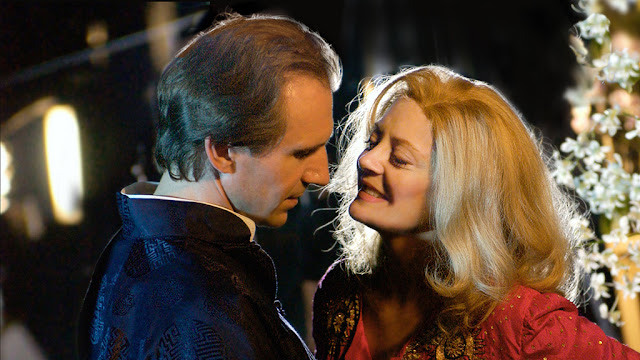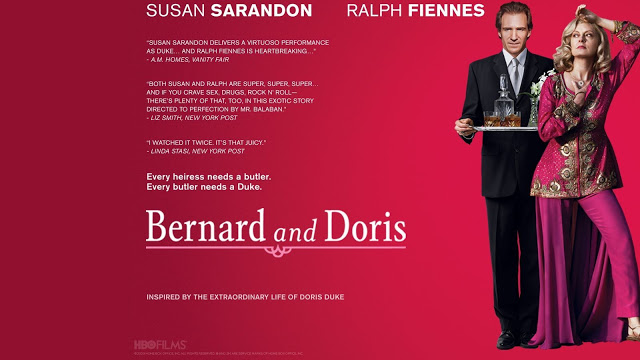 |
| Movie poster for Bernard and Doris |
But the question, again, is do you ever really want to ever be intimate? If you do, then it might as well be this person. It’s not about gender. It’s not about race, or age, or anything. The hurdle is intimacy. –Susan Sarandon (on Bernard and Doris, from the movie’s official site).
Duke controversially changed her will near the end of her life in 1993, leaving Lafferty in charge of her enormous estate. After her death he was accused of manipulation, and even murder. But while the script uses some of the facts of Duke and Lafferty’s time together to begin and end the story, it’s not concerned with trying to build a case for or against him. Instead of going the Law & Order route, it affixes a great big disclaimer in the opening credits in order to play with fictional interpretations.
The result is more than a chance to gawk at the excesses and indulgences of a wealthy woman and her lavish property, or speculate as to what exactly happened in Duke’s final days. Thanks in large part to the brilliant performances by Sarandon and Fiennes, it’s an examination of a peculiar combination of people in extraordinary circumstances who develop a deep bond.
 |
| Susan Sarandon as multimillionaire Doris Duke |
With her elaborate outfits, fluffy dogs (played by Sarandon’s own pets), and sturdy sexual appetite, Doris could easily be shown following in the snobbish steps of 48 carat ditzes like Goldie Hawn in Overboard or Claudette Colbert in It Happened One Night. She’s rich and attractive and probably in need of being taken down a peg or two. But the film chooses to revel in Duke’s powers. She’s shown as dominating the various spheres she occupies: business, artistic, political, celebrity. Even her spiritual quest is done with distinct flair: she moves her newly found Indian guru over to America. Doris’s wealth, control and personality are all wrapped up in the New Jersey mansion she hires meek butler Bernard Lafferty to look after.
Doris may be in the habit of shedding staff like so many overchilled cantaloupes, but Bernard proves himself to have an immense practical and empathic capacity. She’s a smart woman who understands the value of a servant who quickly pays off a nurse she’s recently punched out in a plastic surgery clinic.
Bernard is a nurturer, softly spoken and with an awestruck air whenever he’s around Doris. He soaks up every crumb of her attention and is shown trying on her earrings and scarves, lighting up with the reflected glamour. When one of her business managers pushes Doris to fire him, she incredulously points out that he does embroidery.
 |
| Bernard Lafferty (Ralph Fiennes) in an early scene in Bernard and Doris |
But while Bernard and Doris are brought together by money, they find each other a balm for their loneliness. It’s an imperfect match, as rocky and erratic as any long-term serious relationship. He falls off the wagon and loots her wine cellar. She drives drunk with him in the passenger seat. He sets her against her other advisors and monopolises her healthcare. She derides him for being needy. Neither of them maintains graciousness, for all the wealth that saturates them. This is what’s so effective about the movie–demonstrating the state of love they reach when they do get on. When Doris breaks down over Nick’s betrayal and her only child’s death, Bernard offers her pure acceptance. When his drinking lands him back in rehab, she returns it. It’s this volleying of trust back and forth that the two actors’ brilliant performances make believable.
 |
Doris: “I don’t get it. You don’t fuck me; you don’t steal from me. So what do you want from me?” Bernard: “I want to take care of you, Miss Duke.” |
She knows that he’s achieved his dream of shared intimacy, but over a discussion of her funeral plans, she sharply reinstates her superiority, snapping at him, “I must really be crazy to believe a fucker like you.”
Scenes like this pose the question of how little can be known about a close relationship, even from the inside. At the end of the film, Bernard is still inside the house, now the master. Over his head hangs the question of what really passed between him and his former employer. The hothouse environment where Doris grows orchids provides an example of what could have happened, when extremes of wealth, personality, and needs are pushed together to flourish, and possibly rot. Bernard and Doris explores the ambiguities of intimacy between two imperfect people, where there is no happy ever after, but it’s nothing less than a love story to the end.
Margaret Howie is a London-based bookseller who doesn’t need a butler but wouldn’t mind a wine cellar.
